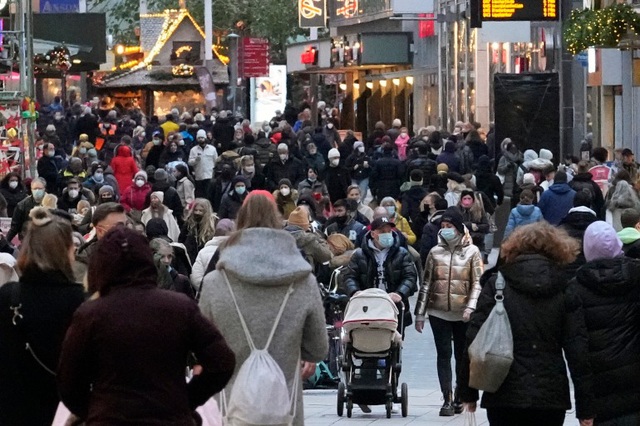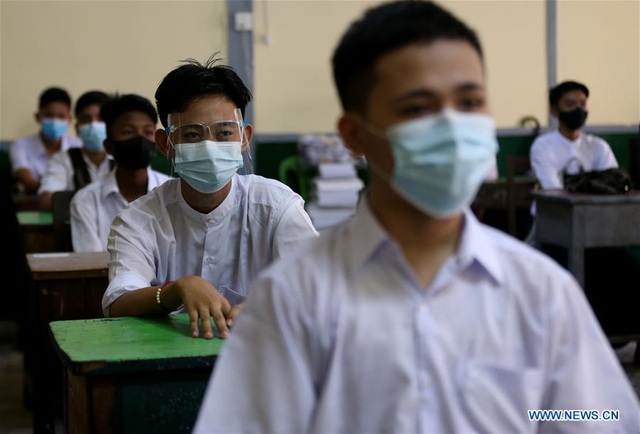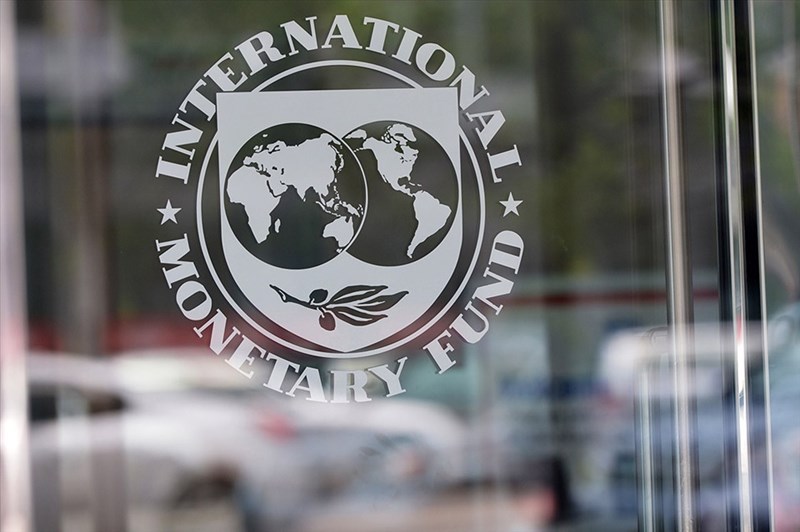COVID-19 shows signs of resurgence in Japan, the number of re-infections in the UK is 10 times higher than at the beginning of the epidemic
More than 487.92 million people worldwide have contracted the SARS-CoV-2 virus. (Photo: AP)
The country most severely affected by the epidemic COVID-19 still America with over 81.75 million cases and more than 1 million deaths. In the past day, the US recorded more than 15,300 people SARS-CoV-2 virus infection.
The US Centers for Disease Control and Prevention (CDC) has lifted its advisory on the risk of COVID-19 infection on cruise ships. The CDC statement stated that the above move does not mean that there is no risk of COVID-19 infection on cruise ships, but travelers will be able to weigh their own risks when choosing this form of travel. similar to self-consideration for other forms of tourism.
The US CDC still recommends that travelers should get vaccinated against COVID-19 before each trip. In addition, people with underlying medical conditions, weakened immune systems, or at risk of severe illness should consult their doctors to take additional precautions.
Although the US Food and Drug Administration (FDA) has allowed people over 50 years of age to receive a second booster dose of COVID-19 vaccine, many public health experts now believe that some young people and stronger in the above group should not rush to get the 4th dose. The FDA announcement as well as the new CDC guidance allows people over 50 years of age to receive the 4th dose of Pfizer-BioNTech or Moderna vaccine at least 4 months after the dose. first booster injection. In addition, people with weakened immune systems can also get a second booster shot. In addition, CDC recommends that people who have received 2 doses of Johnson & Johnson’s vaccine can get a booster shot of Pfizer or Moderna.
At the world’s second largest COVID-19 epidemic center Indiaon March 31, the country recorded a total of over 43.02 million people with COVID-19, including more than 521,000 deaths from COVID-19 in this South Asian country.
Brazil Currently, it is the world’s 3rd largest epidemic hotspot with more than 659,500 COVID-19 patients dying out of a total of over 29.9 million infected people in this country.
Statistics show that, before November 2021, Brother less than 1% of re-infections were recorded. However, this has become more common after Omicron variant appeared at the end of November 2021. Accordingly, the number of re-infections this year in the UK has been about 10 times higher than at the beginning of the pandemic.
According to experts, the reason why more and more people get COVID-19 again is due to the appearance of Omicron, a variant believed to be able to “evade” the “defense systems”, which are formed from old infections. Fortunately, most people who get a second COVID-19 infection rarely develop a severe illness. Laboratory studies show that Omicron infection and vaccination will make the body better prepared against the risk of new infections. In the UK, around 4.5 million people have received booster shots since the start of this year.
In fact, most people can contract corona viruses, including strains that cause common colds that anyone can catch many times in a lifetime. The Omicron variant is believed to be the main cause of pushing the number of infections in the UK back to a record high. The data shows that most of the reinfections are young, unvaccinated people.

The number of COVID-19 infections in the UK has risen back to a record high. (Photo: AP)
Health Minister Bulgaria Assena Serbezova said that the country will cancel all COVID-19 prevention measures from the beginning of April, including the regulation of wearing masks in enclosed spaces and a travel ban for foreigners coming from foreign countries. countries where the epidemic situation is still serious. In addition, other measures that have also been lifted are limiting the capacity of restaurants, theatres, events, mandatory social distancing and online learning. All foreigners will be allowed to enter the country if they present a valid certificate of COVID-19 such as having been vaccinated or recovered from the disease or having a negative test result.
The move comes after the Bulgarian Government decided to end the nationwide alert that was imposed two years ago, when the disease began to break out in this Balkan country. Currently, Bulgaria has the lowest rate of vaccination against COVID-19 in the European Union (EU) with less than 30% of the population getting the full basic dose. To date, the COVID-19 pandemic has claimed the lives of 36,498 people in Bulgaria, a country of 7 million people.
Government Switzerland The country will lift the remaining restrictive measures still in place because of the COVID-19 epidemic from April 1, in the context that Switzerland is trying to live with the disease. Accordingly, the regulation of wearing masks on public transport and at medical facilities, as well as the requirement to self-isolate for 5 days after contracting COVID-19, will be canceled. The Swiss government will also temporarily cancel the Swiss COVID app that identifies people in close contact with others who have the virus.
According to the Swiss government, the decision was made after high vaccination rates and no sudden increase in the number of critical cases in recent weeks, although the number of new infections is still increasing. The Swiss government believes that the pandemic may not be over but will become endemic with seasonal waves of infections likely in the future.
The number of new infections in Switzerland remained high with 16,462 new infections recorded on March 30 and 8,177 on March 31. To date, Switzerland has recorded a total of over 3.48 million people, or 41% of the country’s population, with COVID-19, including 13,709 deaths. Currently, 69% of the 8.6 million people in Switzerland have received the full dose of the basic vaccine.
From April 1, visitors come Thailand will not need to take a COVID-19 test prior to departure. Speaking on March 31, a spokesman for Thailand’s Center for COVID-19 Situation Administration (CCSA) said that the country will remove the requirement to have a certificate of negative PT-PCR test results. before departure for travelers entering under the “Test & Go”, “Sandbox” and “Isolation” programs from April 1.
However, people entering under one of these programs will still be required to have an RT-PCR test on arrival. They were also asked to test themselves for antigen on the 5th day of arrival and monitor their health at the property.
In addition, visitors arriving under the “Sandbox” program must stay in the designated area for 5 days. Visitors arriving under the quarantine program, including those caught illegally entering the country, will be quarantined for 5 days and tested for RT-PCR on the 4th or 5th day of arrival.
Universities and colleges in Myanmar will reopen from May 12 to after two years of temporary closure due to the raging COVID-19 pandemic. In a notice on March 31, the Ministry of Education of Myanmar stated that all universities specializing in science and arts, as well as colleges in the country will reopen all classes and courses from March 31. the aforesaid determination. Students who have been matriculated for the 2019-2020 school year may also enroll in first-year classes.

Myanmar will reopen universities and colleges from May 12. (Photo: Xinhua News Agency)
The ministry also said that courses for part-time students of the aforementioned universities will reopen in September and October. Meanwhile, in November, universities will welcome freshmen students. Candidates who have passed the entrance exam in the academic year 2021-2022.
This announcement comes after Myanmar relaxed measures to prevent the COVID-19 epidemic, including allowing gatherings of up to 400 people in public places. According to the latest data from the Ministry of Health of Myanmar, as of March 29, the country has injected more than 49.7 million doses of COVID-19 vaccine to its people.
Malaysia will officially open the border on April 1, after more than two years of closure since the outbreak of COVID-19. Neighboring countries will be the driving force behind the reopening of the “smokeless industry” in this country.
Speaking at the announcement ceremony of the Malaysian Tourism Marketing and Strategy Plan for 2022-2026, the Malaysian Minister of Tourism, Arts and Culture said that the number of international tourists to Malaysia this year will increase. gradually, first from neighboring countries such as Singapore, Thailand, Indonesia, Brunei, then from other Southeast Asian countries and finally from long- and medium-haul markets.
In recent days, there are some signs that the COVID-19 epidemic is resurging in Japan. On March 30, Japan recorded an additional 53,753 cases of COVID-19, an increase of 12,000 cases compared to a week earlier. Meanwhile, on March 31, this number was 52,765 cases. This is the sixth day in a row that the number of new cases in this country has increased. In Tokyo alone, the number of new cases increased 1.5 times from a week earlier, to 9,520 cases. The average number of new cases of SARS-CoV-2 virus in the week from March 24 to March 30 also increased by 21.1%, to 7,622.6 cases/day.
Previously, when the Japanese Government decided to lift key epidemic prevention measures nationwide from March 22. Many health experts have warned that the COVID-19 epidemic could break out again in this country at any time because then the rate of decrease in the number of new infections in some areas was still quite slow. Some experts even think that this Northeast Asian country is still in the 6th wave of infections.
On March 31, the Shanghai government (China) has called on the people to continue to cooperate in implementing the strict restrictive measures applied to prevent the spread of COVID-19. The call comes as Shanghai, the most populous city in China with 26 million people, enters the fourth day of a two-phase blockade.
On March 30, Shanghai reported 5,298 new locally transmitted asymptomatic COVID-19 cases and 355 symptomatic cases, down from 5,656 asymptomatic cases and 326 new symptomatic cases. evidence was recorded the day before. Shanghai accounted for about 80% of asymptomatic COVID-19 cases reported across China as of March 30, and the figure for symptomatic cases was around 20%.
The World Health Organization (WHO) has released an update on its assessment of the COVID-19 epidemic and outlined three possible epidemic scenarios this year. According to the WHO Director-General, the most likely scenario is that the SARS-CoV-2 virus continues to evolve, but the severity of the epidemic will decrease over time, as immunity increases through vaccines and infection.
The second scenario is that less dangerous variants will emerge, and then booster shots or new vaccine formulations may not be needed. The third scenario is that a new strain will appear and will cause the vaccine’s ability to resist infection rapidly.
According to the head of WHO, this will likely be the last update that the organization gives regarding COVID-19 outbreak scenarios.
The persistent COVID symptoms may differ based on the type of variant of the SARS-CoV-2 virus that the patient has. Preliminary research on this is expected to be published at the European Conference on Clinical Microbiology and Infectious Diseases in April. This is the first time that persistent COVID symptoms have been linked to related to different viral variants.
However, the authors acknowledge that there are still many limitations to the study, such as the inability to prove cause and effect, and the fact that it is not possible to confirm which variant the patient has. Researcher Michele Spinicci, one of the authors, said the future “needs to focus on the potential risks of worrisome variants and vaccination status” when studying ongoing symptoms of HIV. patient.
* Invite readers to watch the programs broadcast by Vietnam Television on TV Online and VTVGo!
at Blogtuan.info – Source: vtv.vn – Read the original article here



